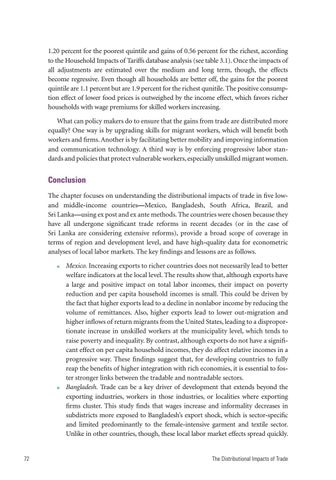1.20 percent for the poorest quintile and gains of 0.56 percent for the richest, according to the Household Impacts of Tariffs database analysis (see table 3.1). Once the impacts of all adjustments are estimated over the medium and long term, though, the effects become regressive. Even though all households are better off, the gains for the poorest quintile are 1.1 percent but are 1.9 percent for the richest qunitile. The positive consumption effect of lower food prices is outweighed by the income effect, which favors richer households with wage premiums for skilled workers increasing. What can policy makers do to ensure that the gains from trade are distributed more equally? One way is by upgrading skills for migrant workers, which will benefit both workers and firms. Another is by facilitating better mobility and impoving information and communication technology. A third way is by enforcing progressive labor standards and policies that protect vulnerable workers, especially unskilled migrant women.
Conclusion The chapter focuses on understanding the distributional impacts of trade in five lowand middle-income countries—Mexico, Bangladesh, South Africa, Brazil, and Sri Lanka—using ex post and ex ante methods. The countries were chosen because they have all undergone significant trade reforms in recent decades (or in the case of Sri Lanka are considering extensive reforms), provide a broad scope of coverage in terms of region and development level, and have high-quality data for econometric analyses of local labor markets. The key findings and lessons are as follows. ■■
■■
72
Mexico. Increasing exports to richer countries does not necessarily lead to better welfare indicators at the local level. The results show that, although exports have a large and positive impact on total labor incomes, their impact on poverty reduction and per capita household incomes is small. This could be driven by the fact that higher exports lead to a decline in nonlabor income by reducing the volume of remittances. Also, higher exports lead to lower out-migration and higher inflows of return migrants from the United States, leading to a disproportionate increase in unskilled workers at the municipality level, which tends to raise poverty and inequality. By contrast, although exports do not have a significant effect on per capita household incomes, they do affect relative incomes in a progressive way. These findings suggest that, for developing countries to fully reap the benefits of higher integration with rich economies, it is essential to foster stronger links between the tradable and nontradable sectors. Bangladesh. Trade can be a key driver of development that extends beyond the exporting industries, workers in those industries, or localities where exporting firms cluster. This study finds that wages increase and informality decreases in subdistricts more exposed to Bangladesh’s export shock, which is sector-specific and limited predominantly to the female-intensive garment and textile sector. Unlike in other countries, though, these local labor market effects spread quickly. The Distributional Impacts of Trade

